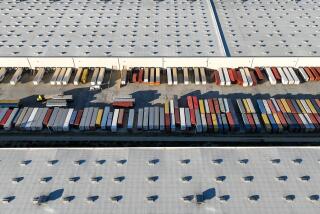Thinking Outside Big-Box Zoning
Here’s how a budget analyst for San Juan Capistrano describes the Home Depot proposed for a site near downtown:
It’s like a big bowl of spinach. The city might not like the taste, but it’s good for them.
Much about the proposal for the home-improvement store has residents turning up their noses--traffic, pollution and the harm a city report shows it will cause to small businesses downtown.
Yet City Council members say the windfall in sales taxes the mega-size retailer will bring is too enticing to ignore.
It’s another case of “cash-box zoning,” an unintended side effect of 1978’s landmark Proposition 13 that has become entrenched statewide.
Despite what most planners agree is a glut of “big boxes,” malls and other retail projects in Southern California, local officials continue to court mega-stores, seeing them as the only viable opportunity to generate new revenue when it’s extremely difficult to raise property taxes.
Cities have taken to setting aside as much land as they can for large retail projects, often at the expense of desperately needed housing.
Municipalities fight with each other for stores, and approve new retail centers just across city lines from existing ones, even when indications are that there will not be enough business for both to thrive.
“We’ve created an incentive to chase these big boxes to the detriment of everything else,” said Marlon Boarnet, professor of regional planning at UC Irvine.
“We need to get smarter about how we grow as a region.”
There is a move in Sacramento to shift sales taxes from cities and replace the revenue with a regional pool communities would share. The hope is that by taking away the financial incentive for mega-stores, cities and counties will practice better planning.
A law approved by the Assembly in January would launch the first test case in a group of counties around the capital.
Long spurned as an intrusion on home rule, this kind of lawmaking to address issues regionally is gaining momentum.
Among the loudest advocates is the Speaker’s Commission on Regionalism, a group organized by Assemblyman Robert Hertzberg (D-Sherman Oaks) to identify ways cities can work together to tackle growth issues.
The commission’s final report, released this year, urges a series of reforms that would “reduce the fiscal incentive for retail.”
They include shifting a bigger share of property taxes away from the state and to the cities, in exchange for cities giving some of their sales tax revenue to the state.
That would at least provide an incentive to cities to add more residential zoning, which would bring some relief to the regional housing crunch.
Many real estate analysts say it’s about time.
“Cities are addicted to sales tax,” said Larry Kosmont, a Los Angeles-based real estate consultant. “We have such a convoluted tax system that it is rational for a city official to say, ‘Let’s get this into our community, because if we don’t, we lose out,’ as opposed to asking what is the highest and best use for a site.
“Cash-box zoning has driven us into a dry spell when it comes to housing productivity.”
Kosmont said one Home Depot can generate more revenue for a city than thousands of homes, thanks to Proposition 13’s limits on property taxes. The upshot is that city officials view homes as added expenses and big-box retailers as new cash streams.
It’s not just housing that loses out to the big boxes.
Lancaster was so worried about the prospect of losing a Costco that it gave up some prime parkland to keep the store in town. After the retailer threatened to flee to neighboring Palmdale--and take the sales tax revenue with it--Lancaster handed over 4.5 acres inside its 71-acre city park, where the company will remove about 100 trees to build a 148,000-square-foot store.
Cypress city officials are moving to seize an 18-acre parcel owned by Cottonwood Christian Church for a Costco--despite parishioners’ protests. Cottonwood bought the land in 1999 to build a sanctuary and auditorium for its 4,000 members, but the city says a retail center anchored by Costco is a better use for the busy neighborhood.
Experts say the rush to generate sales tax also has resulted in the overbuilding of smaller retail centers in many cities. Santa Ana planners reported in a recent study that they have 40% more strip malls than traffic can justify on the city’s west side.
Anaheim planners also are grappling with an overabundance of stores in parts of their city and are trying to replace some with affordable housing.
The proposed state law for the six-county region around Sacramento would establish the kind of tax-sharing many planners support. Future growth in local sales taxes would be pooled for cities to share.
The bill has sparked heated opposition from critics who argue that it’s an effort to steer funds away from wealthy suburbs and redistribute them to less-affluent areas. Even some advocates of regionalism question whether cities will find the approach too unpalatable.
“I’m skeptical of having the state swooping up a locally levied tax and redistributing it,” said Fred Silva, senior advisor at the Public Policy Institute of California.
He believes that it may take a new tax to launch an effective regional land-use system--be it a regional sales tax, a new motor vehicle fee or even an income tax--something not a lot of lawmakers are ready to line up behind.
Otherwise, he said, “You are taking revenue away from local governments. I don’t think you can get past the tension that will cause.”
More to Read
Sign up for Essential California
The most important California stories and recommendations in your inbox every morning.
You may occasionally receive promotional content from the Los Angeles Times.











